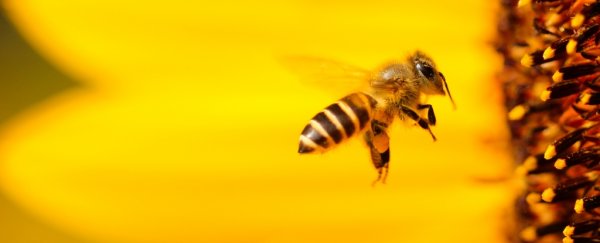Researchers have discovered that bees can have a preference for left or right - influencing their decisions while they navigate obstacles in flight.
Unlike humans, though, bees don't seem to favour one or the other across the wider population. But any individual bee could either be strongly left- or right-biased in equal proportion, and some have no preference at all.
Researchers at the University of Queensland in Australia not only demonstrated bees can have this preference for flying left or right. Through their testing, the team also found bees could distinguish between a smaller hole and a larger one, choosing the larger (and potentially less hazardous) option to fly though.
"Some bees display a strong left bias, others a strong right bias, and yet others a weak or zero bias," explained neuroscientist and engineer Mandyam Srinivasan.
To determine the 'handedness' of the bees, the team tracked 102 foraging bees dabbed with different coloured paints to distinguish them from each other.
The bees were then introduced into a 120 centimetre (47 inch) long tunnel with a feeder at the far end, and an obstacle in the middle containing two different openings that the researchers could vary in size and proportion to each other.
When one opening was twice as wide as the other, 80 percent of the time bees chose the larger opening.
But things got interesting when the openings were set to the same size. Around 55 percent of the bees showed no preference for one hole or the other over at least 10 flights through the tunnel. Of the remaining 45 percent, half preferred the left and half preferred the right.
When the biased bees were timed going through the tunnel with uneven openings, things got particularly interesting. If a bee's preferred side was smaller, it would take a longer time trying to decide which hole to go through - their favoured side, or the larger one.
Conversely, if their favoured side was the larger one, the amount of time they took to make their choice was shorter.
The insects join a growing list of animals that demonstrate handedness. Rhesus monkeys, rats and marmosets have all demonstrated the trait. Some other insects have, too.
Bumblebees have demonstrated a turning preference, and individual locusts have demonstrated a preference for which limb to extend when walking across a gap.
For locusts, this could be a mechanism for reducing the amount of computation time it takes to perform an action. But given the trait is not demonstrated in all individuals, the explanation does not account for those that don't show a preference.
The University of Queensland researchers believe their results could suggest an optimised swarm flight strategy.
"Let us consider a (simplified) scenario in which a group of bees is faced with a choice of flying through one of two clear passages through a thicket of branches," the researchers wrote in the paper.
"It would be detrimental if all the bees possessed the same bias, say, toward the left, as a population bias of this kind would make all individuals try to fly through the left-hand passage, thus blocking each other, and slowing down as well as endangering the passage of the swarm through the thicket.
"In this case, the right-hand passage would not be used at all, and therefore would be wasted. On the other hand, it would also not be beneficial to have zero bias in each of the bees, because if the two passages were of unequal size, a group of unbiased bees would all try to fly through the wider passage, overcrowding it and again slowing down progress."
Previous research from Srinivasan's laboratory found that the reason birds don't crash in mid-flight is because they always veer to the right, managing to safely avoid each other. That research could be used to develop automated anti-crash systems for aircraft.
This new research with bees, on the other hand, Srinivasan said, could help develop systems for steering drones. The aircraft kind, not the bee kind.
The research has been published in the journal PLOS One.
